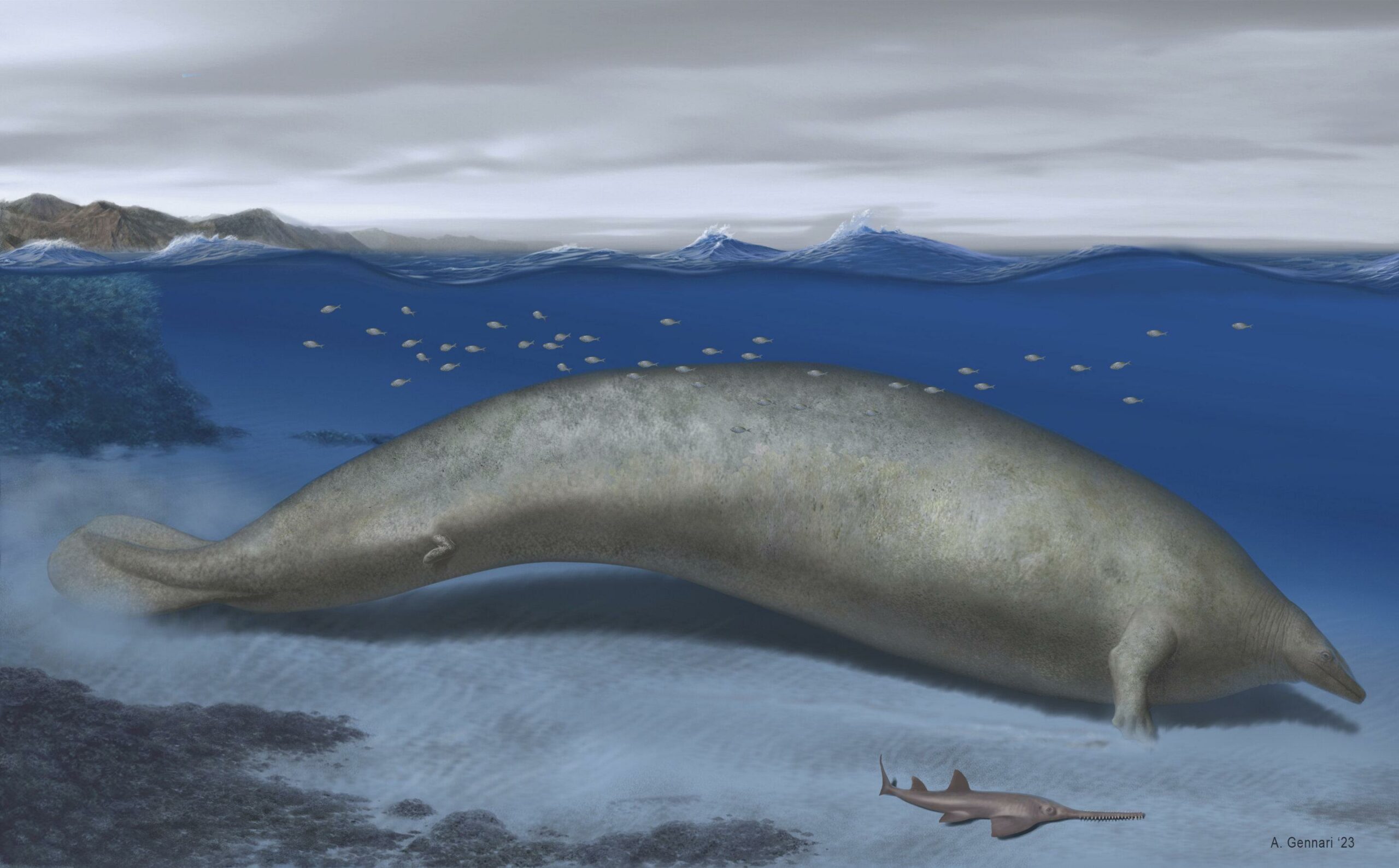An ancient whale known as Perucetus colossus, which existed during the Eocene epoch around 38-40 million years ago, has been discovered in Peru and documented by scientists.

A creature, resembling a manatee, was suggested to be heavier than the blue whale, which has long been thought to be the heaviest animal in existence.
The results of Italian researchers were published in the scientific journal Nature. According to their estimations, the Perucetus, or “colossal Peruvian whale”, was likely around 20 meters in length and weighed up to 340 tonnes, surpassing the mass of all known animals, including the blue whale and the biggest dinosaurs.
Giovanni Bianucci, a paleontologist from the University of Pisa, commented that the most impressive attribute of this creature was its immense size, highlighting that evolution can produce creatures with characteristics that exceed the bounds of our imagination.
The ocean floor is illuminated by the silhouette of a marine mammal, which is constructed similarly to a manatee, swimming beneath the surface. A shadow of a marine mammal that is structured like a manatee is cast onto the ocean floor.
The lower bound for the weight of Perucetus was determined to be 85 tonnes, and the mean estimate was 180 tonnes. The heaviest ever recorded blue whale weighed an estimated 190 tonnes and measured 33.5 meters in length, which was larger than the Perucetus.

In May, a scholarly paper assigned the title of “most-massive dinosaur” to Argentinosaurus, a long-necked, four-legged herbivore that lived approximately 95 million years ago in Argentina. This particular dinosaur is estimated to have weighed a whopping 76 tonnes.
In the coastal desert of Peru’s south, a whale fossil-filled area, the skeleton of Perucetus was unearthed. The bones discovered included 13 vertebrae, four ribs, and a single hip bone. The bones were extremely dense and compact.
Pachyosteosclerosis, something that is not found in existing cetaceans such as whales, dolphins, and porpoises, is a feature that is present in the Sirenian family of marine mammals, which includes manatees and dugongs.
The skeleton of the animal weighed between 5 and 8 tonnes, which was at least twice the weight of a blue whale. Mr. Bianucci noted that the animal’s bulky, oversized physique resembled that of a sirenian rather than any whale that is still alive today.
The sirenians have a species that is gigantic and may live similarly to Steller’s sea cow, which was first spotted in 1741, but unfortunately was eradicated by humans shortly after.
Peaceful giant
No traces of skulls or teeth were discovered, making it hard for scientists to interpret the dietary habits and behavior of the creature.
It is believed that Perucetus had a lifestyle similar to that of sirenians, which means it was a creature that foraged for food in the shallow parts of the coast instead of hunting.
Olivier Lambert, a paleontologist from the Royal Belgian Institute of Natural Sciences in Brussels, commented that the mammal’s size would have resulted in a slow rate of movement.
“Because of its heavy skeleton and, most likely, its very voluminous body, this animal was certainly a slow swimmer,” he said. “This appears to me, at this stage of our knowledge, as a kind of peaceful giant, a bit like a super-sized manatee. It must have been a very impressive animal, but maybe not so scary.”
A history of gigantism
According to Mr. Bianucci, it is improbable that Perucetus was a filter-feeder like the blue whale and other modern baleen whales.
“Perhaps it was herbivorous like the sirenians, but this would be the only case among cetaceans or it fed on small mollusks and crustaceans in sandy bottoms like the gray whale. Or it could have been a scavenger on vertebrate carcasses, similar to some extant large-body sharks,” he said.
Around 50 million years ago, Perucetus was a land-dwelling mammal approximately the size of a medium-sized dog. This species served as the ancestor of whales, as evidenced by its vestigial back limbs.
Perucetus was related to Basilosaurus, signified by its skeletal traits. This other early whale was similar in size but not as heavily armed for hunting; it had a sleek body, strong jaws, and small teeth.
According to Mr. Bianucci, Perucetus has revealed that two distinct instances of cetacean gigantism have occurred.
He noted that the large baleen whales evolved in relatively recent times and that the Basilosaurus relatives, with Perucetus being the most remarkable, diversified about 40 million years ago.
The discovery was published in the journal Nature on August 02 2023.



